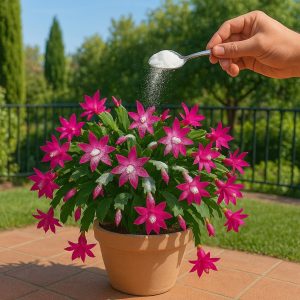The Sweet Truth Behind Sugar and Plants

Plants naturally produce sugars through photosynthesis—this is their fuel for growth. But what happens when we add sugar externally, like in this photo where someone sprinkles sugar onto a flowering plant? Can it really enhance blooming?
1. Sugar as a Short-Term Energy Boost**
Adding a small amount of sugar to the soil or water of flowering plants can sometimes act as a temporary energy boost. Especially in cut flowers, sugar is known to:
* Prolong vase life
* Help petals stay firm and vibrant
* Slow down wilting
This is why many flower food packets include a mix of sugar, acid, and a biocide.
2. Why Too Much Sugar is a Problem**
While a spoon or two might seem harmless (and even beneficial short-term), there are risks:
* Soil Imbalance: Sugar in soil can disrupt the microbial balance, feeding harmful fungi and bacteria.
* *Root Damage*: Excess sugar can create an osmotic imbalance, drawing water out of the roots and causing dehydration.
* Pest Attraction: Sugar attracts ants, aphids, and other pests that can damage your plant.
3. Is This Photo Realistic?**
The image depicts an extremely flower-laden plant that seems to explode with blooms after a sugar sprinkle. While it’s certainly eye-catching, such results from just “2 spoons” of sugar are likely exaggerated or artificially enhanced.
Still, it reflects a deeper truth—certain household items, when used responsibly, can support plant health in specific ways.
4. Best Practices for Using Sugar on Plants**
If you’re curious about experimenting with sugar on your plants, here are some safe tips:
* Dilute: Mix 1 teaspoon of sugar into a liter of water—not directly on the leaves or soil.
* Use on Cut Flowers: Sugar works best in a vase, not in a garden bed.
* Monitor Closely: If you notice mold, wilting, or pest activity, stop immediately.
* Try Alternatives: Molasses or compost teas offer trace sugars plus minerals and microbial benefits.
5. The Real Keys to Abundant Flowers
Rather than relying on sugar alone, make sure your plants have:
* *Good sunlight exposure*
* *Proper watering and drainage*
* *Nutrient-rich soil*
* *Pruning and deadheading when needed*
Organic fertilizers or flower-specific nutrient blends will always outperform sugar in the long run.
Conclusion
While the idea of “two spoons of sugar for magical flowers” makes for a fun experiment (and a great photo), real plant growth relies on balance. Use sugar sparingly if you must, but for lasting beauty and blooms, stick to time-tested gardening principles.
